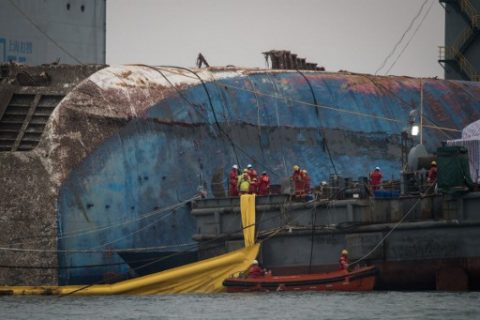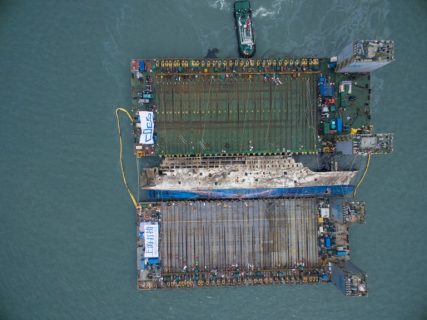
South Koreas sunken Sewol ferry emerged from the waters March 23, nearly three years after it went down with the loss of more than 300 lives and dealt a crushing blow to now-ousted president Park Geun-Hye. / AFP PHOTO / Ed JONES
by Hwang Sunghee
Agence France Presse
JINDO, South Korea (AFP) –South Korea’s sunken Sewol ferry was sailed away from its watery grave Friday, beginning its final journey nearly three years after it went down with the loss of more than 300 lives.
A flotilla of powerful tugs towed the wreck, lying on its side on a platform between two giant salvage barges, towards a semi-submersible that will finally bring it into port.
The 145-metre ship was brought to the surface in a complex salvage operation believed to be among the largest recoveries ever of a wreck in one piece, a key demand of the families of the dead.
“The Sewol began its move towards the semi-submersible at 16:55,” (0755 GMT) the maritime ministry said in a statement.
The rusted, silted hull stood high out of the water, with both its white superstructure and blue bulbous bow exposed as it was taken towards the Dockwise White Marlin, a huge vessel standing by in deeper waters to bring it to Mokpo on the mainland, for investigations and a search.
Almost all the dead were schoolchildren and it is thought that nine bodies still unaccounted for may be trapped inside the sunken ship.
“Today is the last day of the neap tide and we must finish loading the Sewol to the submersible,” Lee Cheol-jo, a ministry official in charge of the operation told reporters earlier, referring to when tides are at their weakest.
Around 450 workers were involved in the painstaking salvage.
The Sewol has a displacement of 6,825 tonnes but is now estimated to weigh between 8,000-8,500 tonnes including the silt piled up inside.
It came as the third anniversary approached of one of the country’s worst-ever maritime disasters, which dealt a crushing blow to now-ousted president Park Geun-Hye.
Several relatives watched the much-anticipated operation unfolding from a boat near the site.

South Koreas sunken Sewol ferry emerged from the waters March 23, nearly three years after it went down with the loss of more than 300 lives and dealt a crushing blow to now-ousted president Park Geun-Hye. / AFP PHOTO / POOL / Lee Myung-Ik
“I had seen footage of the vessel from time to time, but there are no words to describe what I’m feeling to see it above water,” said Jung SeongWook, a father who lost his son in the deadly accident. “I cried. I could only think about my son,” he told AFP after a boat trip to the wreck site.
Jung is among a handful of bereaved family members who have kept watch at a camp on a hilltop on the nearest island Donggeochado, just 1.5 kilometres (a mile) away.
– ‘My heart stops’
Other bereaved family members gathered at Paengmok harbour on the nearby larger island of Jindo, huddled in front of a small computer monitor for any updates to the salvage operation.
“From time to time when the news mentions a possible obstacle, my heart stops,” said Yoo Young-Hwa, who lost her daughter on the Sewol.
The vessel was lying more than 40 metres (130 feet) below the waves off southwestern South Korea and the operation, originally scheduled for last year, had been pushed back several times because of adverse weather.
The disaster was a crippling blow to the now-ousted leader Park Geun-Hye, whose dismissal over a corruption scandal was confirmed by Seoul ‘s top court only two weeks ago.
She stayed at her residence for the first few critical hours after the disaster while officials were frantically sending updates and asking for guidance.
She has never specified what she was doing for the seven hours, sparking wild rumours including a tryst and cosmetic surgery.
A permanent Sewol protest site targeting her was subsequently set up in the centre of Seoul.
Investigations into the disaster, in which 304 people died, concluded it was largely man-made — the cumulative result of an illegal redesign, an overloaded cargo bay, inexperienced crew and a questionable relationship between the ship operators and state regulators.
Even though the vessel took around three hours to sink, many of those on board never heard any evacuation order, while the crew were among the first to escape to safety.
Captain Lee Jun-Seok was sentenced to life in prison for “murder through wilful negligence” and 14 other crew members were given terms ranging from two to 12 years.
sh/slb/kb © Agence France-Presse








